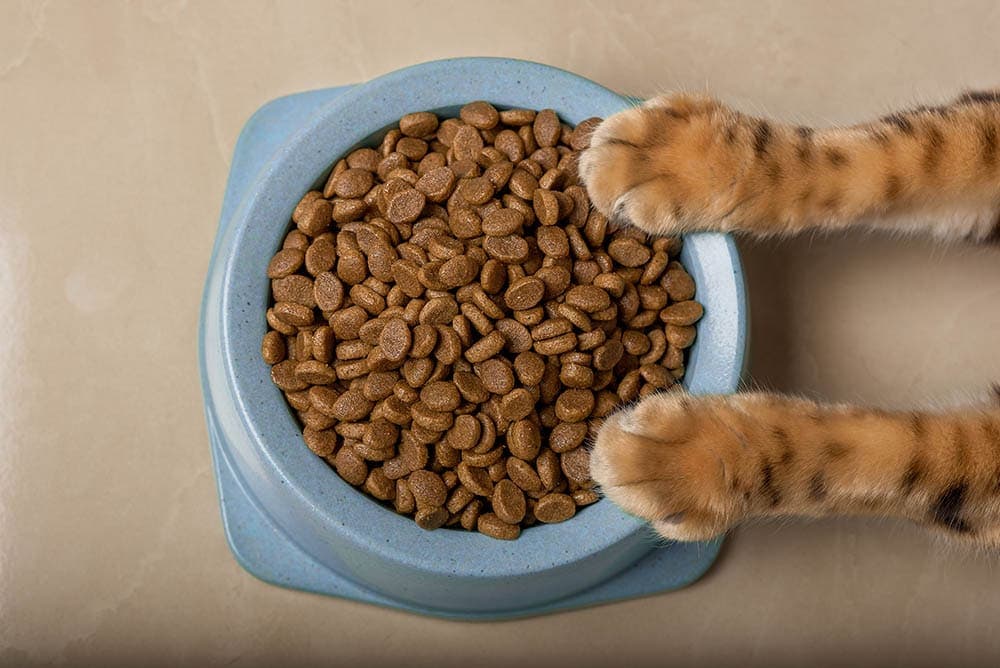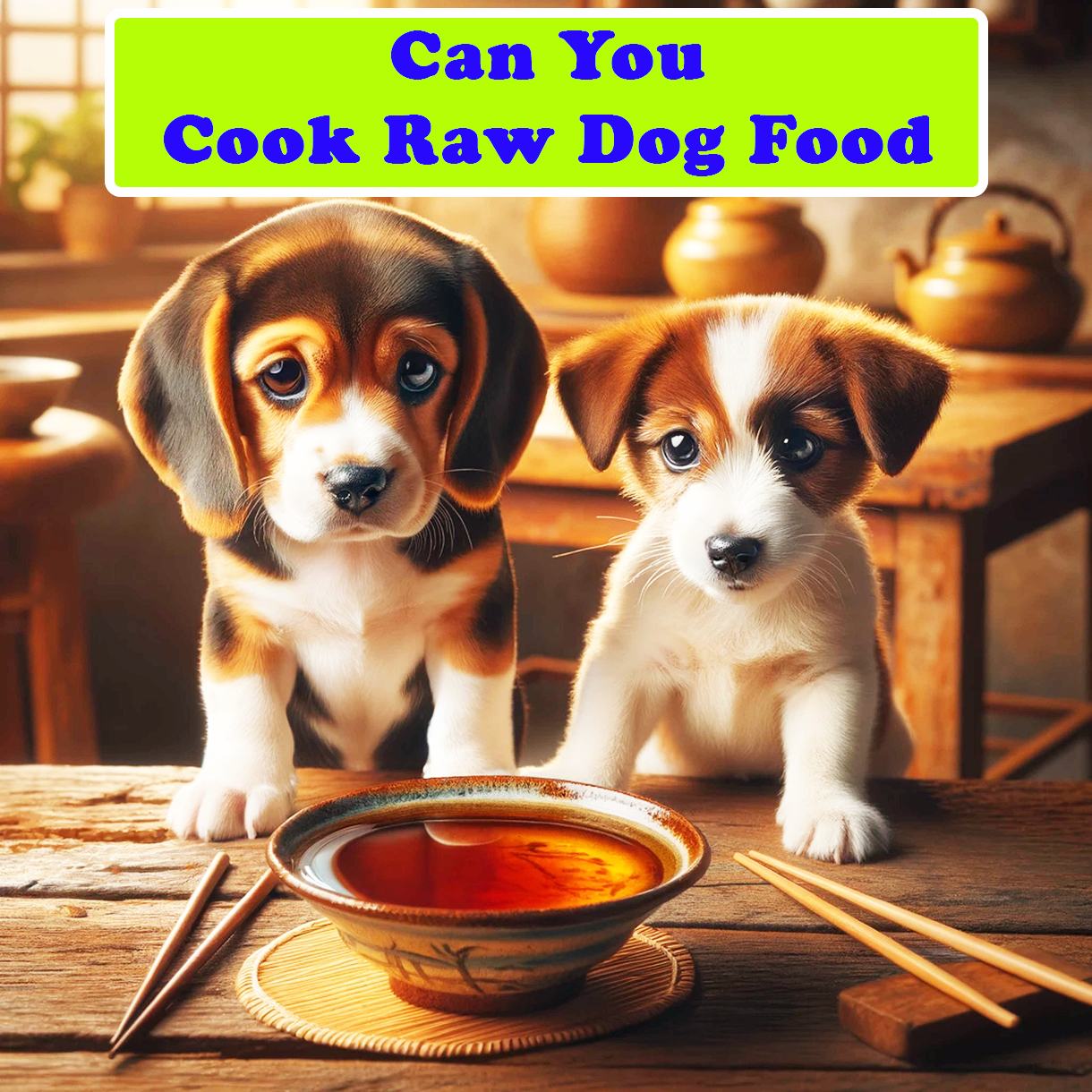Can you cook raw dog food safely? You can safely cook raw dog food to ensure your pet’s health and well-being.
Cooking for your dog is becoming increasingly popular as pet owners seek healthier and more natural options for their furry friends. One option that many pet owners consider is raw dog food, which is made up of fresh, unprocessed ingredients like meat, fruits, and vegetables.
While feeding your dog raw food has advantages, some pet owners may prefer to cook it before serving it to their furry friend. This can help eliminate any potential risks associated with raw feeding, such as bacterial contamination. We’ll explore the topic of cooking raw dog food, discuss its benefits, and provide guidelines on safely preparing cooked meals for your canine companion. So, let’s delve into cooking raw dog food and discover how it can benefit your pet’s overall health and dietary needs.

Credit: everythingraw.ca
The Basics Of Raw Dog Food
Yes, you can cook raw dog food. However, to preserve the nutrients, avoid cooking food at high temperatures. Gentle cooking methods like lightly steaming or baking can help eliminate harmful bacteria while retaining vital nutrients for your dog’s health.
What Is Raw Dog Food?
Raw dog food consists of uncooked meat, bones, fruits, and vegetables. This means

the food is not processed or cooked before being served to your furry friend. It simulates the natural diet of dogs in the wild, which typically consists of raw meat, bones, and vegetation. Feeding your dog raw food gives them a more natural and balanced diet closer to what their ancestors would have eaten.
Benefits Of Raw Dog Food
There are several benefits associated with feeding your dog a raw food diet. Here are a few of the main advantages:
1. Improved Digestion: Raw dog food is more accessible for dogs to digest since it contains natural enzymes and has not been processed. This can lead to better absorption of nutrients and less digestive discomfort.
2. Healthier Coat and Skin: The nutrients in raw food, such as omega-3 fatty acids, can help promote a healthy coat and skin for your furry friend. This can result in reduced itching, fewer skin allergies, and a shinier coat.
3. Increased Energy Levels: When dogs have a more biologically appropriate diet, their energy levels tend to increase. This is because raw food provides the essential nutrients and energy sources dogs need to thrive.
4. Dental Health: Chewing on raw bones can help keep your dog’s teeth clean and strong. Chewing and crunching on bones can help remove plaque and tartar buildup, promoting dental health.
5. Weight management: Diets strong in protein and low in carbs are common in raw dog food, which can assist dogs in keeping a healthy weight.
This can be particularly beneficial for dogs prone to obesity or weight-related health issues.
6. Better Overall Health: A balanced raw dog food diet can improve immune function, improve muscle development, and reduce the risk of chronic diseases. By providing your dog with the nutrients it needs, you can help support its overall health and well-being.
In conclusion, feeding your dog a raw food diet can have various benefits, including improved digestion, healthier skin and coat, increased energy levels, enhanced dental health, weight management, and overall better health. However, it is essential to consult with a veterinarian or a veterinary nutritionist before making any significant changes to your dog’s diet to ensure that it is appropriate and balanced for their specific needs.

Credit: bookauthority.org
Understanding The Risks
Before cooking raw dog food, it’s crucial to be aware of the risks associated with this practice.
Potential Dangers Of Raw Dog Food
- Bacterial Contamination: Raw food can harbor harmful bacteria like Salmonella.
- Nutritional Imbalance: Incorrect recipes may lead to nutrient deficiencies or excesses.
- Risk of Choking: Bone fragments in raw meat could pose a choking hazard.
Safety Measures To Consider
- Use High-Quality Ingredients: Ensure all ingredients are fresh and of good quality.
- Follow Proper Hygiene: Thoroughly wash hands, utensils, and surfaces to prevent contamination.
- Consult a Vet: Seek advice from a vet to create balanced recipes tailored to your dog’s needs.
Cooking Raw Dog Food
You can safely cook raw dog food at home to ensure your dog’s nutrition and safety. Following proper food safety guidelines and consulting with a veterinarian to create a balanced diet for your furry friend is essential. Cooking raw dog food can be a healthy and cost-effective option for your pet’s diet.
Balancing Nutritional Requirements
Cooking raw dog food is a great way to ensure your furry friend gets the nutrients necessary for a healthy and balanced diet. When preparing raw dog food, it is essential to consider the right balance of proteins, fats, carbohydrates, vitamins, and minerals for your dog’s specific needs.
Here are some key points to keep in mind when balancing nutritional requirements:
- Proteins: Include high-quality protein sources in your dog’s raw food, such as lean meats, poultry, fish, and eggs. Protein provides the building blocks for muscle development and repair.
- Fats: Incorporate healthy fats like salmon or flaxseed oil into the recipe. Fats provide energy and assist with nutrient absorption.
- Carbohydrates: Add a small amount of carbohydrates, such as cooked vegetables or grains, for fiber and additional energy.
- Vitamins and Minerals: Include a variety of fruits and vegetables to provide essential vitamins, minerals, and antioxidants.
Safe Handling And Preparation
When cooking raw dog food, it is crucial to ensure safe handling and preparation to prevent contamination or foodborne illnesses.
Follow these guidelines to ensure the safety of your dog’s food:
- Use Clean Utensils: Wash all utensils, cutting boards, and countertops thoroughly before and after preparing raw dog food. This helps prevent cross-contamination.
- Separate Food Items: Keep raw dog food ingredients separate from human food to avoid any potential contamination.
- Proper Storage: Store raw meat and other perishable ingredients in the refrigerator or freezer to maintain freshness and prevent bacterial growth.
- Cook Meat Thoroughly: If you cook the meat partially, ensure it is fully cooked before feeding it to your dog to eliminate harmful bacteria.
- Monitor Temperature: Check the temperature of cooked food to ensure it is safe for consumption. Use a food thermometer to measure the interior temperature precisely.
Adhering to these safe handling and preparation practices can minimize the risks of cooking raw dog food and provide a healthy meal for your beloved pet.
Nutritional Guidelines
Discover how to cook raw dog food with nutritional guidelines for a balanced diet suited to your pet’s needs. Ensure proper handling of ingredients for safety and optimal health benefits. Unlock the secrets to preparing wholesome meals that support your furry friend’s well-being.
Essential Nutrients For Dogs
Proper Food Combinations
Nutritional guidelines for cooking raw dog food include prioritizing essential nutrients and proper food combinations. Dogs need a balanced diet to thrive, so pet owners must understand this when preparing raw food for their furry friends.
Essential Nutrients For Dogs
Incorporating proteins, fats, carbohydrates, vitamins, and minerals into your dog’s diet is essential. Proteins are crucial for muscle health, fats provide energy, and carbohydrates offer vital nutrients. Vitamins and minerals support overall well-being. Properly balanced nutrition is critical for your dog’s health.
Proper Food Combinations
Balancing proteins, carbohydrates, oils, and nutrients is crucial. A suitable combination of ingredients ensures a complete and balanced diet for your furry companion. Consult a veterinarian to create a diet plan tailored to your dog’s needs. Pay attention to portion sizes to prevent overindulging.
Transitioning To Raw Food
Transitioning your dog to a raw food diet is a necessary process that must be approached carefully. Dogs used to a processed diet may experience gastrointestinal upset if the switch to raw food is too abrupt. Here’s how to make this transition smooth and beneficial for your furry friend.
Gradual Diet Transition
Gradually introduce raw food by mixing small portions with your dog’s diet. Over several days, gradually increase the proportion of raw food while decreasing the processed food. This will allow your dog’s digestive system to adjust and reduce the risk of gastrointestinal issues.
Monitoring Your Dog’s Health
Observe your dog’s health closely during the transition period. Look out for any signs of discomfort, such as diarrhea or vomiting. Watch their vitality and general state of health. Consider slowing the transition process or consulting with a veterinarian if you notice any issues.
Expert Tips For Cooking Raw Dog Food
The art of cooking raw dog food is essential for pet owners who want to provide their furry friends with balanced and healthy meals. To help you excel in this aspect, we’ve compiled expert tips for cooking raw dog food to ensure your canine companion receives the best nutrition possible.
Choosing Quality Ingredients
When crafting raw dog food, prioritize high-quality ingredients to give your pet essential nutrients. Opt for fresh meats, such as chicken, turkey, or beef, and include organ meats like liver or kidney to supply vital minerals and vitamins. Incorporating vegetables such as broccoli, carrots, and spinach adds fiber and essential nutrients to the mix.
Avoiding Common Mistakes
One common mistake to avoid is failing to provide a variety of ingredients, as this can lead to nutritional deficiencies. Additionally, be cautious of raw bones that may splinter and cause harm to your pet. Ensure your raw dog food recipes comply with canine dietary requirements to prevent adverse health effects.
Special Considerations
There are a few special considerations to remember when cooking raw dog food. These considerations address sourcing raw ingredients and managing health conditions and dietary restrictions.
Sourcing Raw Ingredients
Sourcing high-quality raw ingredients is essential when preparing raw dog food. The following advice will help you locate the best ingredients:
- Choose organic options whenever possible.
- Buy from local farmers or farmers markets to support local businesses.
- Look for meat that is free from hormones and antibiotics.
- Consider purchasing frozen ingredients, as freezing helps eliminate harmful bacteria.
- Research reputable suppliers that specialize in raw pet food products.
Health Conditions And Dietary Restrictions
Like humans, dogs may have health conditions or dietary restrictions requiring special food consideration. Here are a few things to think about:
- Consult a veterinarian or canine nutritionist to determine your dog’s needs.
- Be aware of your dog’s food allergies, and avoid those ingredients.
- Work with your veterinarian to formulate a balanced diet if your dog has a specific health condition, such as kidney disease or pancreatitis.
- Introduce new ingredients gradually to monitor your dog’s reaction and ensure they tolerate them well.
- As your veterinarian recommends, consider adding supplements, such as omega-3 fatty acids or digestive enzymes.
By considering these special considerations, you can ensure that your raw dog food is delicious and provides optimal nutrition for your furry friend.
Final Thoughts
Many wonder if it can be cooked regarding raw dog food preparation. Discover if cooking raw dog food is safe and healthy for your canine companion.
Final Thoughts
Long-Term Health Impacts
Consulting with a Canine Nutritionist
In conclusion, cooking raw dog food can positively impact your dog’s health in the long term.
Consider consulting with a canine nutritionist for expert guidance when preparing raw food.
A balanced diet is crucial for your dog’s wellbeing. A nutritionist can provide tailored advice.
Taking proactive steps now can prevent potential health issues later on.
Ensure your dog’s diet meets their individual needs for optimal health.

Credit: www.dogster.com
Cooked dog food
Cooked dog food has gained popularity as pet owners increasingly prioritize the health and well-being of their furry companions. Unlike traditional dry kibble, cooked dog food offers a fresh and nutritionally balanced alternative, often made from high-quality ingredients for human consumption. This premium approach to feeding pets involves cooking meat, vegetables, and grains together to create wholesome meals that cater to a dog’s dietary needs.
By eliminating preservatives and artificial additives commonly found in commercial dog food, cooked meals provide a natural and easily digestible option for pets with sensitive stomachs or allergies. Moreover, cooking dog food allows pet owners to customize meals based on their dog’s preferences and nutritional requirements, ensuring optimal nourishment for a healthy and active lifestyle.
With a focus on freshness and quality, cooked dog food reflects a growing movement towards holistic pet care, emphasizing the importance of nutrition in promoting longevity and vitality for our beloved canine companions.
Can you cook raw dog food every day?
Warming up raw dog food is common among pet owners to enhance palatability and aid digestion. While raw diets for dogs are typically served cold, gently warming the food can release aromas, intensifying its appeal to your furry friend.
To warm raw dog food, allow it to sit at room temperature for a short while, or place it in a microwave-safe dish and heat it for a few seconds, ensuring it doesn’t get too hot to avoid destroying essential nutrients.
This slight temperature increase can mimic the natural warmth of freshly caught prey, which wild canines often consume. Additionally, warming the food may make it more enticing for dogs with sensitive teeth or those transitioning from dry kibble to raw diets. Always monitor the temperature closely to prevent overheating and maintain the nutritional integrity of the food.
Frequently Asked Questions On Can You Cook Raw Dog Food
Can I Heat Raw Dog Food?
Yes, you can heat raw dog food. It’s safe and can help enhance the aroma. Heating the food around body temperature can make it more delicious for your dog. Just be sure to avoid overheating to keep the nutrients intact.
How Do You Gently Cook Raw Dog Food?
To gently cook raw dog food, simmer it in water or bone broth for 10-15 minutes. Do not overcook to retain nutrients. Use a low heat setting and stir regularly. Avoid adding seasoning, and serve at a safe temperature for your dog to enjoy.
Is It Better To Feed Cooked Or Raw Meat To Dogs?
Raw meat is better for dogs as it retains more nutrients and natural enzymes that benefit their health. However, ensuring the meat is fresh, properly handled, and balanced with other nutrients is essential.
Can You Cook Nature Menu Raw Dog Food?
Yes, you can cook Nature’s Menu raw dog food to ensure food safety for your pet.
Conclusion
Cooking raw dog food is a convenient and healthy option for pet owners. By preparing the food at home, you control the quality and ingredients, ensuring your dog gets a balanced and nutritious diet. However, it is essential to do thorough research, consult a veterinarian, and follow proper food safety guidelines to avoid potential health risks.
Remember, your dog’s well-being should always be the top priority!

I’m a Canada, UAE, US, and UK-based writer and dog expert blogger. I spent over five years learning about dog food and grooming techniques. Additionally, I recommend avoiding and properly treating various physical problems in dogs. I am here to share my knowledge about good dog nutrition and care.

